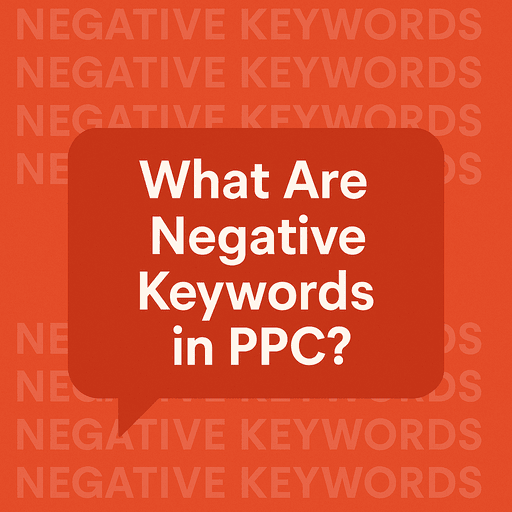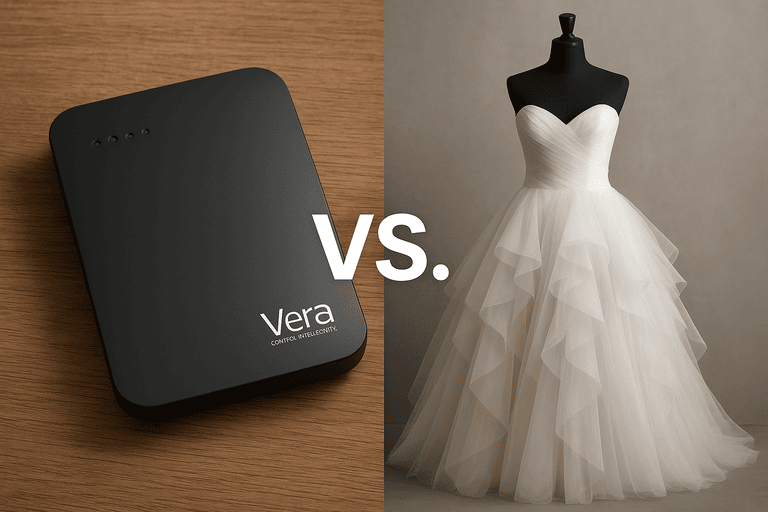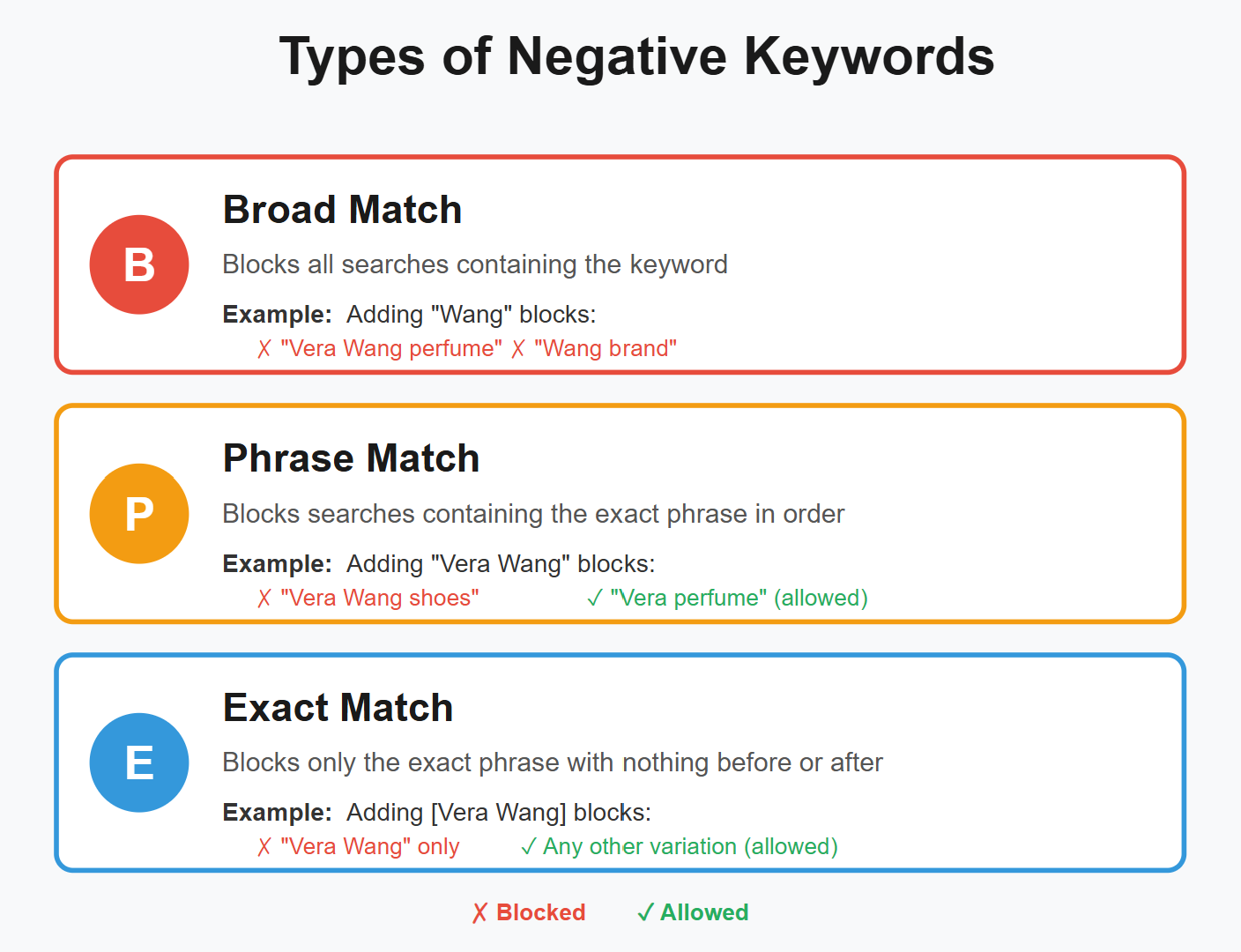What Are Negative Keywords in PPC, and Do I Need Them?

Short Answer: Negative keywords in PPC tell Google Ads which search terms not to show your ads for. They prevent wasted clicks, improve targeting accuracy, and help you make every ad dollar count.
When Ads Target the Wrong “Vera”
When I managed Google Ads campaigns for Home Controls Inc., we sold a Vera smart home controller, a popular smart home hub at the time. It was performing well, but there was one big problem: the keyword “Vera” was also tied to Vera Wang, the high-end fashion designer.
Our ads began showing to shoppers searching for “Vera Wang dresses,” “Vera Wang perfume,” and “Vera Wang wedding gowns.” None of those users were looking for home automation equipment.

That’s when I added “Wang” and “Vera Wang” as negative keywords, telling Google Ads not to show my ad when someone searched those terms. Instantly, impressions dropped in the fashion category, clicks became more relevant, and our conversion rate improved.
That small adjustment saved hundreds of wasted dollars and improved our campaign ROI.
What Are Negative Keywords in PPC?
Negative keywords are words or phrases that tell Google Ads what not to match your ads with. They act like filters, helping you reach users with the right intent while avoiding irrelevant searches.
For example, if you sell luxury hotels, you might add “cheap” or “free” as negative keywords so your ads don’t appear for “cheap hotels” or “free lodging.”
Negative keywords don’t stop your ad entirely; they fine-tune when and where it appears, saving your budget from low-quality clicks.
Types of Negative Keywords You Can Use

There are three main types of negative keywords:
-
Broad match negative keywords: block searches that contain all the negative terms in any order.
-
Example: adding “Wang” blocks “Vera Wang perfume” and “Wang brand.”
-
-
Phrase match negative keywords: block searches that contain the exact phrase.
-
Example: adding “Vera Wang” blocks “Vera Wang shoes” but not “Vera perfume.”
-
-
Exact match negative keywords: block only that specific term.
-
Example: adding [Vera Wang] blocks just that phrase and nothing else.
-
Using the right match type depends on how broad or specific you want your exclusions to be.
Why Are Negative Keywords Important in Google Ads?
Every click costs money, so every irrelevant click hurts your Quality Score and your ROI. Without negative keywords, your ad may appear for unrelated searches that burn through your budget.
In the Home Controls example, letting our ads appear for “Vera Wang” searches was like paying to advertise to the wrong audience. Once those irrelevant impressions were filtered out, performance metrics like CTR and conversion rate improved immediately.
Negative keywords protect your ad spend and make your targeting sharper.
How to Find and Add Negative Keywords
Start with your Search Terms Report inside Google Ads. This report shows the actual phrases people typed before clicking your ad. If you notice irrelevant terms such as “recipes,” “cheap,” or unrelated brands, add them as negatives.
You can also:
-
Use Google Keyword Planner to find related but irrelevant search terms.
-
Check your Search Console or analytics for mismatched traffic.
-
Add negative keywords at the campaign, ad group, or shared list level.
Over time, refine your list by reviewing performance and adjusting as your campaigns evolve.
Common Negative Keyword Mistakes
Even advanced advertisers make errors with negative keywords. Watch out for:
-
Adding too many broad match negatives that limit ad impressions.
-
Neglecting to update your list as new trends emerge.
-
Applying the same negatives across all campaigns when only one needs it.
-
Blocking valuable terms by accident, like “Vera controller setup” instead of “Vera Wang.”
A clean, strategic list works better than an overstuffed one.
Do I Need Negative Keywords for My Campaigns?
Yes, absolutely. Whether you’re running a small local campaign or managing nationwide ads, negative keywords are essential.
Without them, Google may waste your budget on irrelevant traffic that never converts. With them, you get higher-quality leads, better engagement, and smarter spend allocation.
Remember, regular keywords attract clicks. Negative keywords protect them.
How Many Negative Keywords Should You Use?
Start with a short, focused list, maybe 10 to 20 terms identified through your search reports. Then update your list monthly or quarterly.
As your campaigns evolve, you’ll find new search patterns worth excluding. When I managed the Home Controls account, “Vera Wang” was only the first of many. Eventually, we excluded “fashion,” “designer,” and “wedding,” all terms that had no connection to smart home products.
FAQ
What do negative keywords do in PPC?
They tell Google Ads which searches you don’t want your ads to show for, improving ad relevance and reducing wasted spend.
How do I find irrelevant search terms?
Check your Search Terms Report to see exactly what people searched before clicking your ad.
What’s the difference between broad and phrase match negatives?
Broad match blocks searches containing all negative terms in any order, while phrase match blocks the exact phrase.
How often should I update my list?
Review your negative keyword list every month to keep up with shifting trends and new search patterns.
Stop Wasting Clicks: Start Using Negative Keywords Effectively
Negative keywords are one of the simplest but most powerful tools in PPC. They keep your ads relevant, protect your budget, and improve the performance of every campaign.
When used strategically, like filtering out fashion shoppers from a smart home campaign, they can make the difference between wasted clicks and winning conversions.
Need help tightening your PPC strategy? Contact me for a keyword audit and let’s stop wasted spend before it starts.

0 Comments Add a Comment?